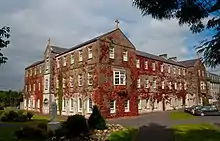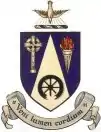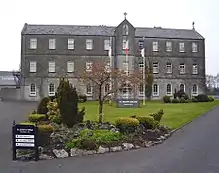St Jarlath's College
St Jarlath's College (Coláiste Iarfhlatha in Irish) is a Roman Catholic secondary school for boys in Tuam, County Galway. It is an amalgamation of the former St Jarlath's College and St. Patrick's College, Tuam both diocesan colleges of the Archdiocese of Tuam. The College was named after Jarlath, or Iarlaith, who founded a monastery in the town when, as legend has it, his chariot wheel broke. St. Patrick’s was named after the patron saint of all of Ireland.
| St Jarlath's College | |
|---|---|
 | |
 St Jarlath's College, founded in 1800 | |
| Location | |
| Information | |
| Type | Secondary school |
| Motto | Veni lumen cordium |
| Religious affiliation(s) | Roman Catholic |
| Established | 1801 (Amalgamated 2009) |
| President | Mr John Kelly |
| Faculty | 43 |
| Enrollment | approx 530 |
| Website | http://www.jarlaths.ie/ |
History

Former St Jarlath's College
The original St Jarlath's College was founded in 1801 by then-Archbishop of Tuam, Edward Dillon, with the aim of preparing young boys for entry into Maynooth Roman Catholic Seminary. Dr Dillon had to seek permission to establish the college from the Protestant Archbishop of Tuam, Dr Beresford. It began with two thatched cottages at the Mall, Tuam later moving to a new building in Bishop Street, now commonly known as "the Old College".
Its first president was Rev Oliver Kelly, who later became Archbishop of Tuam. In 1824, the facilities of the College were enlarged by the erection of additional houses in Bishop Street and in 1856 the site of the present college and grounds was bought by Archbishop McHale. This property was known as Keighrey's Park and a portion of it was used as the town's fair green. McHale continued to set it as a fair green to the town commissioners at a yearly rent of 30 until 1875 in which year the college was extensively enlarged by the addition of two wings to the first building which had been erected in 1858.[1]
Former St Patrick's College
In 1851, Archbishop John McHale had invited the Christian Brothers to Tuam. This Catholic organisation was to play a large part in the development of an educated Catholic middle class in Ireland. The invitation resulted in the birth of Tuam CBS, and later St Patrick's College, a Catholic day secondary school, which was to play an enormous role in the development of the town of Tuam.[2]
Amalgamation

Plans to amalgamate St Patrick's And St Jarlath’s colleges had first been suggested in the late 1990s. At that time, a new school building had been promised by the Government. However, no such building materialised. The phasing out of boarding in St Jarlath's led to a reduced enrolment.
In March 2008, Archbishop Michael Neary, as trustee of both schools, announced to staff that the amalgamation would proceed in the absence of a new school building. The amalgamation process commenced in September 2008 with enrollment of all first year students in St Jarlath's. The process was completed in September 2009 when students from both schools amalgamated into the new school, in the old St Jarlath's building.
Opera
Starting with The Mikado in 1944, the college's Amateur Operatic Society has performed a yearly musical or opera for the local community. The 1969 production, The Quaker Girl was the first to be held in conjunction with Mercy Convent, Tuam. The 2008 Opera was also in conjunction with St Patrick's College, due to the amalgamation process in progress at the time.
The tradition of the annual Opera was continued following the amalgamation, the 2009 Opera being the first production of the newly amalgamated school. The Opera has been successful in recent years in the Connacht Tribune organised musical awards, winning a Best Overall and a Best Chorus award in 2008 for Hot Mikado.
Sport
The St Jarlath's College's senior football team hold the prestigious record of winning the Hogan Cup 12 times, more than any other school, and have also been runners-up on a further 14 occasions. The college also holds the record for winning the most Connacht Colleges Senior Football Championships, with an outstanding 48 wins.
Since amalgamation, the school have won two Connacht Senior titles, reaching the Hogan Cup Final in 2011. Under the management of Joe Burke, and captained by Ian Burke from Corofin, the school narrowly lost out to St Colman's College, Newry by just one point.
Sporting honours
Former St Jarlath's College
- Hogan Cup : 12 (1947, 1958, 1960, 1961, 1964, 1966, 1974, 1978, 1982, 1984, 1994, 2002)
- Connacht Colleges Senior Football Championship : 46 (1932, 1933, 1934, 1935, 1936, 1937, 1938, 1939, 1943, 1944, 1945, 1946, 1947, 1950, 1951, 1953, 1956, 1958, 1960, 1961, 1962, 1963, 1964, 1965, 1966, 1967, 1972, 1973, 1974, 1976, 1978, 1979, 1982, 1983, 1984, 1990, 1992, 1993, 1994, 1999, 2000, 2001, 2002, 2003, 2007, 2008)
- Paddy Buggy Cup (All-Ireland Colleges Senior 'B' Hurling Championship) : 1
New St Jarlath's College
- Connacht Colleges Senior Football Championship : 2 (2011, 2012)
- Hogan Cup Runners-Up : 1 (2011)
Notable staff
- J. J. Cribbin — worked as Prefect of Studies[3]
- Elaine Feeney — Irish writer[4]
- Michael Meehan — the former Galway Gaelic footballer teaches mathematics[5][6]
Selected past pupils
- John Birmingham — well known amateur geologist and astronomer
- John Blowick — co-founder of the Missionary Society of St. Columban
- Thomas Carr — former archbishop of Melbourne, Australia
- Enda Colleran — former Gaelic footballer for, and later manager of, Galway
- Damien Comer — Gaelic footballer for Galway
- J. J. Cribbin — Gaelic footballer for Mayo, played for the school team[7]
- Seán Óg De Paor — former Gaelic footballer for Galway
- Michael Donnellan — former Gaelic footballer for Galway
- Patrick Duggan — former bishop of Clonfert
- Peter Fallon — Columban priest kidnapped and killed by Japanese forces in 1945 in the Philippines
- Seán Flanagan — Fianna Fáil politician and Gaelic footballer
- John Heneghan — Columban priest kidnapped and killed by Japanese forces in 1945, in the Philippines, alongside Peter Fallon
- Jim Higgins — Member of the European Parliament for the North–West constituency of Ireland
- Monsignor James Horan — Parish Priest of Knock, responsible for the building of Ireland West Airport
- Colm Keaveney — TD, Labour Party and Fianna Fáil
- Thomas J. Kelly — Irish Nationalist and former leader of the Irish Republican Brotherhood
- Mark Killilea — politician, former Member of the European Parliament for the North–West Constituency
- Michael P. Kitt — former Teachta Dála (TD) for the Galway East constituency
- Tom Kitt — former Teachta Dála (TD) for the Dublin South constituency
- Patrick Lavelle - nicknamed Patriot Priest Of Partry
- Seamus Leydon — former Gaelic footballer for Galway
- Patrick Anthony Ludden — first bishop of Syracuse, New York
- Michael Lyster — former RTÉ presenter
- Kevin McStay — former Gaelic footballer, played for the school team[8]
- Michael Meehan — former Gaelic footballer for Galway
- Michael Neary — current archbishop of Tuam
- Patrick O’Boyle- Bishop of Killala, 1950-1970
- John O'Connor Power — M.P. for Mayo (1874-1885), Orator
- John O'Donohoe QC — Senator for Ontario, Canada (1882-1902)
- Seán Purcell — Gaelic footballer for County Galway
- John Sheehy — former British colonial official
- Tomás Tierney — former Gaelic footballer for Galway and Mayo
Presidents
Old St. Jarlath's College
| Name | From | To |
|---|---|---|
| Very Rev. Oliver Kelly (later Archbishop of Tuam) | 1800 | 1806 |
| Very Rev. Paul McGreal | 1806 | 1817 |
| Very Rev. James MacHale | 1817 | 1821 |
| Very Rev. Thomas Feeney | 1821 | 1831 |
| Very Rev. Martin Brown | 1831 | 1837 |
| Very Rev. James Ronan | 1837 | 1838 |
| Very Rev. William Cullinane | 1838 | 1842 |
| Very Rev. John Flanelly | 1842 | 1845 |
| Very Rev. Anthony Regan | 1845 | 1849 |
| Very Rev. Peter Reynolds | 1849 | 1852 |
| Very Rev. John McEvilly (later Archbishop of Tuam) | 1852 | 1857 |
| Very Rev. Patrick O’Brien | 1857 | 1865 |
| Very Rev. Ulick Bourke | 1865 | 1878 |
| Very Rev. Patrick Kilkenny | 1878 | 1888 |
| Very Rev. Michael O'Connell | 1888 | 1893 |
| Very Rev. John Fallon | 1893 | 1898 |
| Very Rev. Michael McHugh | 1898 | 1903 |
| Very Rev. Michael Higgins | 1903 | 1910 |
| Very Rev. Michael Conroy | 1910 | 1915 |
| Very Rev. Alex Eaton | 1915 | 1923 |
| Very Rev. Denis Ryder | 1923 | 1928 |
| Very Rev. Joseph Walsh (later Archbishop of Tuam) | 1923 | 1940 |
| Very Rev. Tim Gunnigan | 1940 | 1947 |
| Very Rev. Conor Heaney | 1947 | 1961 |
| Very Rev. Michael Mooney | 1961 | 1971 |
| Very Rev. Michael Walsh | 1971 | 1977 |
| Very Rev. Thomas Waldron | 1977 | 1986 |
| Very Rev. Dermot Maloney | 1986 | 1994 |
| Very Rev. Oliver Hughes | 1994 | 2003 |
| Very Rev. Conal Eustace | 2003 | 2008 |
St Jarlath's College (post-amalgamation)
| Name | From | To |
|---|---|---|
| Very Rev. Brendan Kilcoyne | 2008 | 2013 |
| Mr. John Kelly | 2013 | - |
References
- "Tuam Schools in the Nineteenth Century". Places.galwaylibrary.ie. Retrieved 8 July 2017.
- "St. Jarlaths College | Boys Secondary School, Tuam, Co. Galway". Jarlaths.ie. Retrieved 8 July 2017.
- Melvin, John (8 May 2020). "Death of former Mayo footballer Fr. J.J. Cribbin". The Connaught Telegraph. Retrieved 8 May 2020.
- "elaine-feeney". RCW Literary Agency. Retrieved 21 April 2020.
- "Some of the New Staff Members in SJC". 17 November 2011. Archived from the original on 8 February 2019.
- Donoghue, Eamon (23 January 2015). "Schools GAA: Michael Meehan sparking St Jarlath's revival as tradition dies hard". The Irish Times.
Today Meehan is back where it all began, teaching, managing and helping St Jarlath’s adapt to a very different Hogan Cup landscape, made all the harder for them since 2006 when they ended the option for pupils to board in the school... In his third year teaching maths in the school, Meehan is also managing the school's junior footballers, having moved up from managing the first years for the previous two years.
- "Mayo GAA mourn death of former footballer Fr JJ Cribbin". Hogan Stand. 10 May 2020. Retrieved 10 May 2020.
- Moran, Seán (11 April 2020). "Finishers: How the evolution of substitutes has changed Gaelic football". The Irish Times.
Kevin McStay, former Roscommon manager and a football analyst with this newspaper, remembers the past when he began playing in the 1970s and things were simpler and more clear cut... 'when I was at school in St Jarlath's I was on a team that never played subs. It wasn't until the end of my time there in the late 1970s that Jarlath's started using subs.